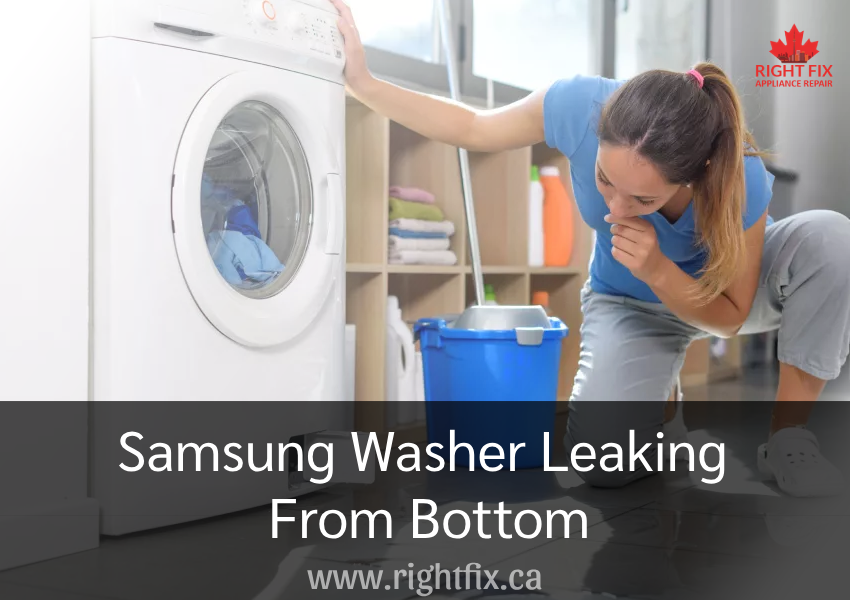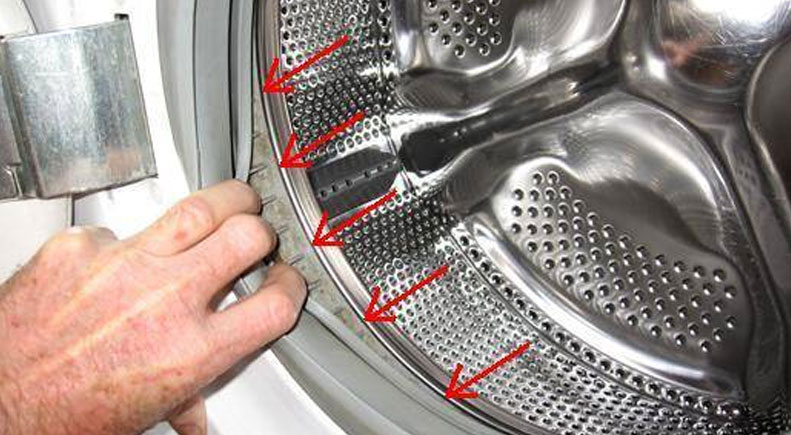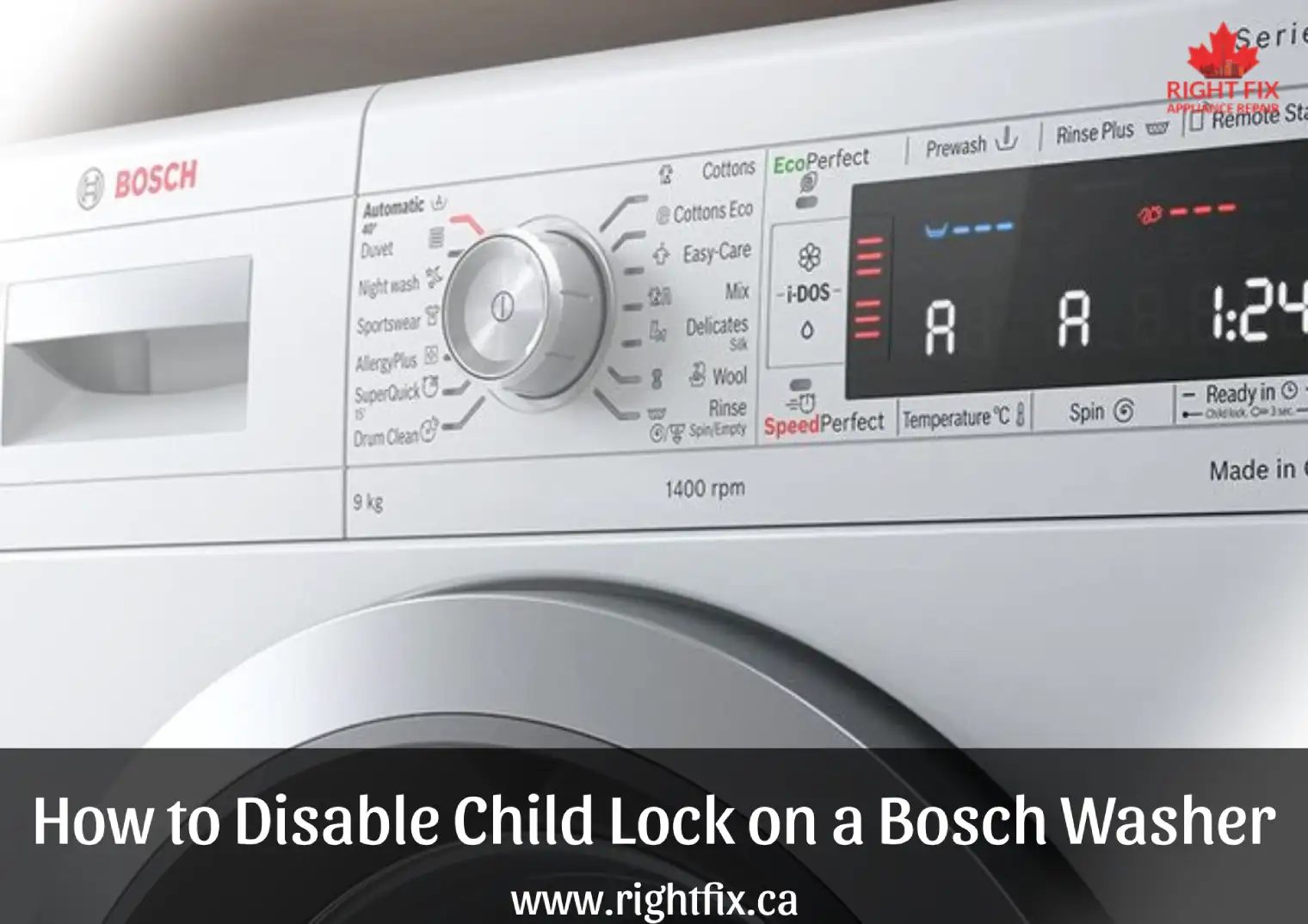Samsung Washer Leaking From Bottom – What To Do?
You should take quick care of the problem if you have observed that your Samsung washer leaks from the bottom. In addition to causing water damage in your laundry room, a leak could point to more major washing machine concerns. The typical causes of leaks will be discussed in this article along with how to find the source of the leak and actions you could take to properly fix the problem. Contact professional washer repair technician from RightFix.
What Causes My Samsung Washing Machine to Leak from the Bottom?
Knowing the basic reasons for a leak will enable you to quickly identify and resolve the issue. These are some typical causes your Samsung's bottom leak from might be:
Cause #1: Damaged Gaskets
Leaks are often caused by broken gaskets. Made from rubber seals, gaskets provide a watertight barrier separating the machine from the washing door. Constant door opening and shutting causes these gaskets to degrade, break, or wear out over time. Should the door seal be damaged, water will readily leak during wash cycles. Visually look at the door seal for cracks, rips, or wear-related indicators of this problem. Should damage be noted, replacing the gasket will help to fix the leak.
Cause #2: Blocked Pump Filter
A clogged pump filter is another often occurring source of leakage. Lint, hair, and other trash that could gather during washing is intended to be trapped by the pump filter. Should the filter choke, water might back up and flow from the machine's bottom. Good drainage depends on routinely cleaning the pump filter. Refer to the user handbook for your washer to find and clear a clogged pump filter should you believe it to be the source of your leak.
Cause #3: Defective Drain Hose
Wastewater from the washers moves via the drain line from the washer to your domestic drainage system. Leaks might follow from a broken, kinked, or incorrectly placed drain pipe. Make sure the drain hose is firmly attached to the washers and check for any wear, including holes or cracks. Should problems arise, changing the drain pipe might be required to stop leaks.
Cause #4: Improper Leveling
If your washer is off-level, water will pool at the bottom. An unlevel washing machine may cause too strong vibrations, which might cause water to spill out whilst running. Invest in a leveling tool to see if your washer is level. Should it not be, change the leveling feet at the machine's base until it is balanced. This one easy action may help correct poor leveling and stop leaks.
Cause #5: Faulty Water Inlet Valve
The water entering the washing machine is under control via the water intake valve. Should this valve fail or be incorrectly attached, water might seep onto the floor. Examine the valve for any indications of rust or damage; furthermore, make sure the connections are tight. Changing the water inlet valve might stop further leaks should you find any.
How to Identify the Source of the Leak
Effective repair depends on the source of the leak being found. These guidelines will assist you to identify the source of the water:
Step 1: Check the Door Seal
First look at the door seal for any obvious damage. Look for wear, rips, or cracks. Should the seal show compromise, it may have to be changed to stop leaks during use.
Step 2: Inspect the Drain Pump for Leaks
Look then at the drain pump for any obvious leakage. Search for water either leaking from the device or collecting around the pump's base. Should you see leaks, the drain pump can require replacement or repair.
Step 3: Review the Water Inlet Valve
Additionally looked at for damage should be the water intake valve. Search for corrosion, rust, or loose connections possibly generating leaks. Changing a defective valve will help to halt the leaks very successfully.
Step 4: Assess Hoses and Connections
Review every hose and connection carefully. Look for any wear or damage, like loosening fittings or cracks. By tightening any loose connections, one may assist stop leaks brought on by incorrect sealing. Damage to hoses calls for replacement to provide a watertight connection.
How to Repair a Samsung Washer with Bottom Leaks
Use these guidelines to fix your Samsung washer after you have found the leak:
Step #1: Replace the Door Gaskets
Should the door gaskets prove broken, they will have to be replaced. Usually, this procedure entails removing the old gasket and then installing a new one. Make sure the new gasket tightly closes the door to provide a correct seal. This fix may assist stop leaks arising while the washer's running.
Step #2: Clean the Pump Filter
Preventing blockage-induced leaks from the pump filter depends on its being cleaned. Usually placed either front or rear of the washers, find the pump filter. Clear any collected trash or lint from the filter then rinse it under running water. Reinstall the filter after cleaning to restore correct drainage.
Step #3: Inspect Hoses and Connections
Look for wear or damage on any hoses and connectors. Replace any hoses you see damaged or frayed to guarantee a safe connection. Make sure every connection is snug and strong as well to avoid leaks from flimsy fittings.
Step #4: Ensure the Washer is Level
Move the leveling feet at the appliance's base to guarantee your washer is level. Check the washer for balance using a level instrument. By making this little change, water won't pool at the bottom and leaks won't result.
Step #5: Replace the Water Inlet Valve
Replacing the water intake valve can help to halt leaks should you discover it to be faulty. Before going further, disconnect the washers from the water source and power supply. Eliminate the old valve and replace it so that all connections are tight.
Conclusion
If your Samsung's washer leaks from the bottom, fast resolution of the problem is essential to save further damage. Knowing the typical reasons and locating the leak can help you to properly fix your appliance. Future leaks will be avoided with regular maintenance including hose inspections, filter cleaning, and gasket checks.
Should the issue continue despite your best efforts or if you find yourself uncomfortable doing these repairs on your own, think about consulting RightFix for expert advice. Our knowledgeable staff can identify and fix your washing machine so it runs as it should once again. We take great joy in our dedication to client happiness and high-quality service, therefore enabling you to maintain flawless functioning of your laundry.
Tips for Preventing Future Leaks
-
Regular Maintenance: Plan frequent cleanings and inspections to maintain your washer in excellent running order.
-
Monitor Usage: Steer clear of overloading your washer to minimize component stress.
-
Educate Yourself: Learn typical washing machine problems to spot early on.
Following these rules and fixing leaks right away will help your Samsung washer last as long as it should and stay efficient.
Is your Samsung washer not spinning? Find out the common reasons and how to fix the issue in our comprehensive guide: Samsung Washer Not Spinning. Get your washer back to working order today!
REFERENCES
https://www.samsung.com/ca/support/home-appliances/samsung-washer-water-leaks/
Location we Service
- Ajax
- Alliston
- Aurora
- Bolton
- Bradford
- Brampton
- Brantford
- Burlington
- Caledon
- Cambridge
- Concord
- East York
- Etobicoke
- Georgetown
- GTA
- Guelph
- Halton Hills
- Hamilton
- Innisfil
- Keswick
- King City
- Kitchener
- Kleinburg
- Maple
- Markham
- Milton
- Mississauga
- New Tecumseth
- Newmarket
- North York
- Oakville
- Orangeville
- Oshawa
- Pickering
- Richmond Hill
- Scarborough
- Schomberg
- Stouffville
- Thornhill
- Toronto
- Unionville
- Uxbridge
- Vaughan
- Waterloo
- Whitby
- Woodbridge


























